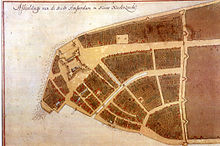Fort Amsterdam (New York)
Fort Amsterdam was the administrative seat and fortress of the Dutch West India Company on Manhattan Island , now a part of New York .
Early days
On May 4, 1626, the new Governor General of the West India Company, Peter Minuit , arrived with some settler families by ship from Holland on Manhattan and began building Fort Amsterdam. The fort was intended to be both the headquarters of the West Indian Company for their New Netherlands colony on the North American continent, as well as military protection for the company's employees and the settlers brought by the company to Manhattan and the surrounding area.
The first structure on the site intended as a fort at the southern tip of Manhattan was a log house surrounded by a picket fence. In October 1628 a ship reached Amsterdam with the message that Fort Amsterdam had been completed with four bastions and stone outer walls.
In 1629 the West India Company decided with a document not only to trade with the colony, but also to bring settlers into the colony for the development of the colony. In point XXXI of this document dated June 7, 1629, the company promises to complete "the fort on the island of Manhattan" and to put it into defense readiness as soon as possible. The fort, which was reported to be completed in 1628, could only have been a very simple construction with a population of 270 Europeans on Manhattan. On August 13, 1630, the said document of the West India Company was announced in Fort Amsterdam, but the colony was not settled on a large scale and the construction work on the fort in the coming decades can be regarded as minor.
Out of town
As additional protection for New Amsterdam, which has grown into a small town around the fort and has around 2000 inhabitants, a wall with a wooden palisade on it was built a few hundred meters north of the fort in 1652 - closing off the southern end of Manhattan Island. Today Wall Street runs along the former wall .
On August 26, 1664, an English squadron arrived in front of New Amsterdam and demanded that the city be surrendered. The city was finally surrendered without a fight. On September 8, 1664, the Dutch garrison troops left the fort and embarked for Holland. The fort was renamed Fort James by the English.
During the turmoil in England in 1688/89 , during which the Dutch William III. of Orange became King of England, Jakob Leisler made himself head of the city of New York in 1689, as New Amsterdam with its Fort Amsterdam has been called since it was renamed by the English in 1664. The German Leisler came to Fort Amsterdam in 1660 as a Dutch officer. In January 1691, English troops landed in New York, against which Leisler holed up in the fort for six weeks until he gave up.
The End
The fort was demolished in 1787 for the construction of Government House, the new seat of the New York Mayor. The Government House served as a customs building for the port of New York from 1815. After the Government House was demolished in 1907, the new customs building was completed on the site of the former Fort Amsterdam and now serves as a museum.
literature
- EB O'Callaghan: “HISTORY OF NEW NETHERLAND; or, NEW YORK UNDER THE DUTCH. ”, New York 1846
- Esther Singleton: "Dutch New York", Dodd, Mead and Company, New York 1909
Individual evidence
- ^ Esther Singleton: "Dutch New York", Verlag Dodd, Mead and Company, New York 1909, page 4
- ↑ EB O'Callaghan: “HISTORY OF NEW NETHERLAND; or, NEW YORK UNDER THE DUTCH. ”, New York 1846, 104
- ^ Esther Singleton: "Dutch New York", Verlag Dodd, Mead and Company, New York 1909, page 5
- ↑ EB O'Callaghan: “HISTORY OF NEW NETHERLAND; or, NEW YORK UNDER THE DUTCH. ”, New York 1846, pages 119-120

